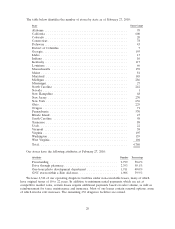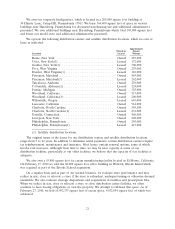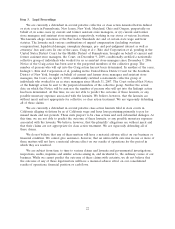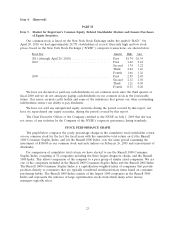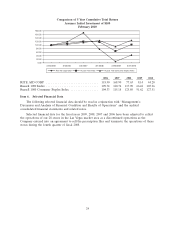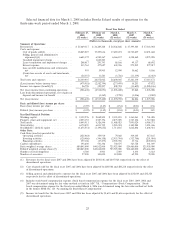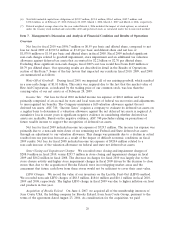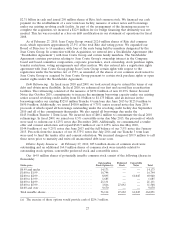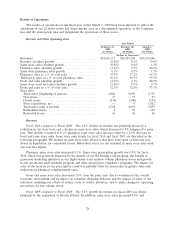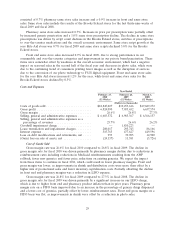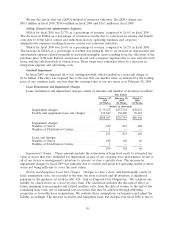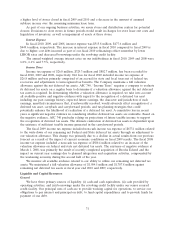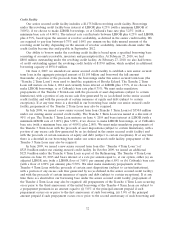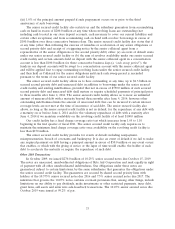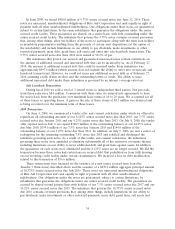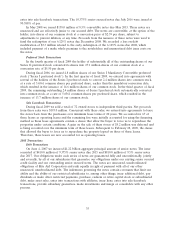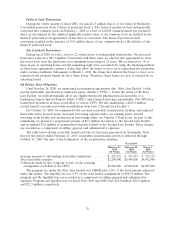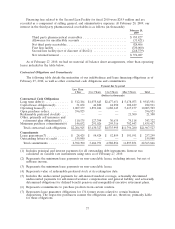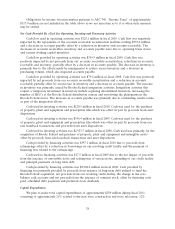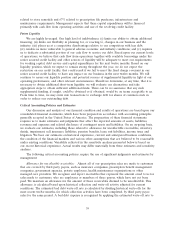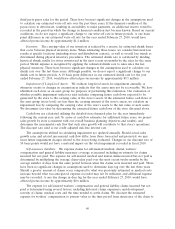Rite Aid 2010 Annual Report Download - page 30
Download and view the complete annual report
Please find page 30 of the 2010 Rite Aid annual report below. You can navigate through the pages in the report by either clicking on the pages listed below, or by using the keyword search tool below to find specific information within the annual report.
We use the last-in, first-out (LIFO) method of inventory valuation. The LIFO charge was
$88.5 million in fiscal 2010, $184.6 million in fiscal 2009 and $16.1 million in fiscal 2008.
Selling, General and Administrative Expenses
SG&A for fiscal 2010 was 25.7% as a percentage of revenue, compared to 26.6% in fiscal 2009.
The decrease in SG&A as a percentage of revenues is mostly due to a decrease in salaries and benefit
costs due to better labor control and reductions in store operating expenses and corporate
administrative expenses resulting from our various cost reduction initiatives.
SG&A for fiscal 2009 was 26.6% as a percentage of revenue, compared to 26.2% in fiscal 2008.
The increase in SG&A as a percentage of revenue was primarily due to an increase in depreciation and
amortization expense related primarily to increased intangible assets resulting from the allocation of the
purchase price of Brooks Eckerd, an increase in rent and occupancy expenses due to new and relocated
stores and the sale-leaseback of owned stores. These items were somewhat offset by a decrease in
integration expense and advertising costs.
Goodwill Impairment
In fiscal 2009, we impaired all of our existing goodwill, which resulted in a non-cash charge of
$1.81 billion. This entry was required due to the fact that our market value, as indicated by the trading
price of our common stock, was less than the carrying value of our net assets as of February 28, 2009.
Lease Termination and Impairment Charges
Lease termination and impairment charges consist of amounts and number of locations as follows:
Year Ended
February 27, February 28, March 1,
2010 2009 2008
(52 Weeks) (52 Weeks) (52 Weeks)
(Dollars in thousands)
Impairment charges ..................... $ 75,475 $157,334 $30,823
Facility and equipment lease exit charges ..... 132,542 136,409 55,343
$208,017 $293,743 $86,166
Impairment charges
Number of Stores ...................... 670 815 420
Number of Distribution Centers ............ 1 — —
671 815 420
Lease exit charges
Number of Stores ...................... 108 162 66
Number of Distribution Centers ............ 1 — —
109 162 66
Impairment Charges. These amounts include the write-down of long-lived assets to estimated fair
value at stores that were identified for impairment as part of our on-going store performance review at
all of our stores or management’s intention to relocate or close a specific store. The increase in
impairment charges in fiscal 2009 was primarily due to current and projected operating results at these
stores not being sufficient to cover the asset values.
Facility and Equipment Lease Exit Charges. Charges to close a store, which principally consist of
lease termination costs, are recorded at the time the store is closed and all inventory is liquidated,
pursuant to the guidance set forth in ASC 420, ‘‘Exit or Disposal Cost Obligations.’’ We calculate our
liability for closed stores on a store-by-store basis. The calculation includes the discounted effect of
future minimum lease payments and related ancillary costs, from the date of closure to the end of the
remaining lease term, net of estimated cost recoveries that may be achieved through subletting
properties or favorable lease terminations. We evaluate these assumptions each quarter and adjust the
liability accordingly. The increase in facility and equipment lease exit charges over fiscal 2008 is due to
30


